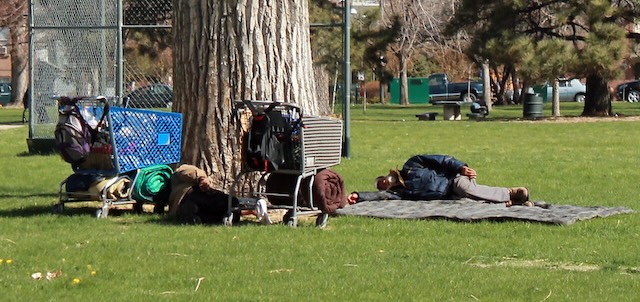More than 650,000 Americans, nearly 2 out of every 1,000, were homeless in January 2023, according to the Department of Housing and Urban Development’s Homeless Assessment Report, which was released last week. This is a 15 percent increase since 2019 — but less than a 1 percent increase since 2007, when HUD first attempted to count the homeless.
Homeless in Denver. Photo by Jeffrey Beall.
New York state has the highest rate of homelessness at 5.2 per 1,000 residents, followed by Oregon at 4.7 (using 2022 population estimates). At the other end of the scale, Mississippi has only 0.3 homeless per 1,000 residents.
There seems to be a sharp contrast between red and blue states. Colorado, a blue state, has 2.5 homeless per 1,000; neighboring Utah is only 1.1 while Kansas and Wyoming are just 0.9.
HUD also keeps track of how many beds are available in homeless shelters and other homeless housing. New York has more homeless beds than it has homeless people, while California is short 110,000 beds, which means that less than 40 percent of California’s homeless can find beds if they want one.
Yet it isn’t clear that building more shelters is the solution. Since 2014, California has built shelters with 3,000 new beds per year but its homeless numbers grew by 7,500 per year. Similarly, Colorado had 10,000 homeless people with only 6,000 beds in 2014. Since then, it has built shelters with 3,000 more beds, but its homeless population grew by 4,000. Meanwhile, Wyoming actually has more beds than it has homeless people.
“Housing First!” is the mantra of the affordable housing industrial complex, which gets federal, state, and local funds for building homeless shelters and other so-called affordable housing. Helping people to stop using drugs and get jobs is supposedly less important than building more homes.
Yet this country suffers from an odd paradox: we have serious labor shortages yet about 5 million working-age men are not working. Maybe if homeless programs focused more on matching homeless people up with jobs, we wouldn’t have to build so many more shelters.









Illinois will spend 9000 dollars for migrant housing.
New York City will spend 5 Billion dollars, 52 thousand per migrant in social and housing costs…………
200 Billion so far to Ukraine
and Israel……..
But Homeless Americans, Fuk em
US Military is one largest land owners, with 26 million acres, for just 1% land could effortlessly build housing for every homeless person in US.
Then again, are they homeless because policies? Land Prices? Housing Prices……….or are they just messing their own lives?
New York City is compensating 25 million to repairs for hotels damaged by homeless, addicts and migrants.
San Francisco is paying millions to hotels.
Maybe, it’s not a housing crisis.
Thus has more to do with culture and depravity crisis.
DRUGS, fuk you up.
Were not seeing rise bad drugs, were seeing rise Good drugs. Victims of modern chemistry from drugs so potent.
And we honestly cant address how they mess with the brain. But were now dealing with the Libertarian fantasy of “Legalized Narcotics”
Land use or its availability is not the issue. There are plenty of empty shelter beds across the country or available homes in Detroit, STL and Cleveland. But many homeless feel the streets are safer than a shelter and we don’t have enough homes in the locations people want to live.
The people trying to fix this problem need to ask AI …
“The difference between symptoms and causes is that symptoms are the signs of a problem, while causes are the underlying reasons for the problem. For example, a fever is a symptom of an infection, while the infection itself is the cause. If you can identify the cause of a problem, you can often treat it more effectively. If you’re looking for more information on a specific topic, please let me know.”
Microsoft Copilot with GPT-4.
Homelessness is a symptom.
Homelessness is a complex problem but when you see a “classic” homeless person wandering the streets and begging odds are very good the root of their problem is mental health. Years ago, they would have been cared for by family or placed in a mental health institution but now it is very difficult to force somebody to accept care if they don’t want it.
There is another group of people classified as homeless who are forced to live in their cars, on friends and relatives couches etc. The costs of housing probably plays a role in their problem but since they are more reasonable people quietly trying to do their best in a difficult situation they don’t make the news nearly as much.
Odd paradox of people who don’t work.
Victims of modern pharmacology, brain sizzling drugs knock iQ down 10 more points…..
Junkie 5 years on opiates is knocked down 10 iQ points
And addicts 7 more years borderline retarded.
They can’t work becuz task management and multitasking require training. That requires short and long-term memory which drugs have fried. They can’t be trained because they’re too dumb multitasking. They can’t be reintroduced to society because they can’t function without perpetual chaperone. They are babies. Adult babies. Violence, fanaticism, poor decision making, inept financial literacy follow these brackets.